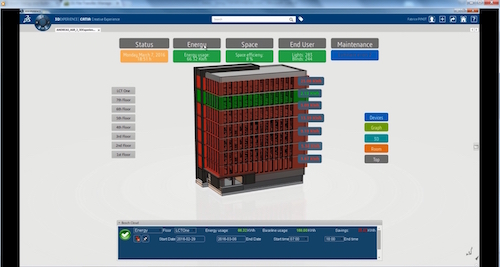Building a Case for Dassault’s Virtual Twin

Dassault’s 3DEXPERIENCity tools are being used to optimize the LCT One building in Dornbirn, Austria. Image Courtesy of Dassault Systemes
Latest News
March 25, 2016
Dassault Systemes’ participation in a collaborative smart office building project in Dornbirn, Austria, is cool not just because it showcases what’s possible from a sustainability standpoint for smart, connected buildings. It also provides some clarity into how the company views the evolving role of the virtual twin.
We’ve written about the rise of the virtual twin (PTC and others call it a digital twin) in product design as a means to connect all kinds of information about a physical product and its behavior in the real world with a 3D digital representation. Dassault views the virtual twin as a step up from the traditional 3D digital mockups of its CAD past, providing insights into a product’s behaviors and allowing collaborators to experience it before it exists in the physical world.
The latest collaboration illustrates how Dassault plans to extend the virtual twin concept beyond the automotive and aerospace & defense spaces, to a new industry domain — in this case, the architecture and building sector. Dassault teamed up with construction giant Rhomberg Group along with Bosch Software Innovations, Zumtobel Group (a manufacturer of lighting technology), and Modcam AB, a connected platform for computer vision, to provide sustainable building management services for the LifeCycle Tower (LCT) One building. The LCT One is one of the most sustainable high-rise buildings made out of an energy-efficient timber system.
 The LCT One building in Dornbirn, Austria, is currently the tallest building made out of an energy-efficient timber system. Image Courtesy of Rhomberg Group
The LCT One building in Dornbirn, Austria, is currently the tallest building made out of an energy-efficient timber system. Image Courtesy of Rhomberg GroupAs part of this initiative, the 3DEXPERIENCE platform was used to aggregate all kinds of digital information about the building — data from the various sensors in the building’s control systems, data from the lighting systems, and 3D models of the building — to create a virtual twin of the building. The 3DEXPERIENCE virtual twin provides real-time insights into the building’s energy usage and technical health, which can be used to optimize energy efficiency, including more effective planning of lighting resources as well as preventive maintenance. Moreover, 3D visualizations of presence data and a heat map depicting occupancy can help optimize usage.
 Dassault’s 3DEXPERIENCE tools are being used to optimize the LCT One building in Dornbirn, Austria. Image Courtesy of Dassault Systemes
Dassault’s 3DEXPERIENCE tools are being used to optimize the LCT One building in Dornbirn, Austria. Image Courtesy of Dassault Systemes“This is not a static geometry model, rather it’s a dynamic data model,” noted Ingeborg Rocker, vice president 3DEXPERIENCity at Dassault. The premiere 3DEXPERIENCity initiative, to be completed by 2018, is “Virtual Singapore,” the first digital twin of an existing city designed to help urban planners optimize and create the sustainable cities of our future.
While the virtual twin is being used to for on-going maintenance and optimization of the LCT One building, Rocker says the concept will evolve in the architecture and building segment to address key milestones in a building’s lifecycle, including simulating construction, testing what-if scenarios, and optimizing performance without interfering with a building’s operation.
Check out this video to view a time lapse chronicle of the construction of the LifeCycle Tower ONE building.
This video provides some insight into where Dassault Systemes is going with its 3DEXPERIENCity platform.
Subscribe to our FREE magazine, FREE email newsletters or both!
Latest News
About the Author
Beth Stackpole is a contributing editor to Digital Engineering. Send e-mail about this article to [email protected].
Follow DE





